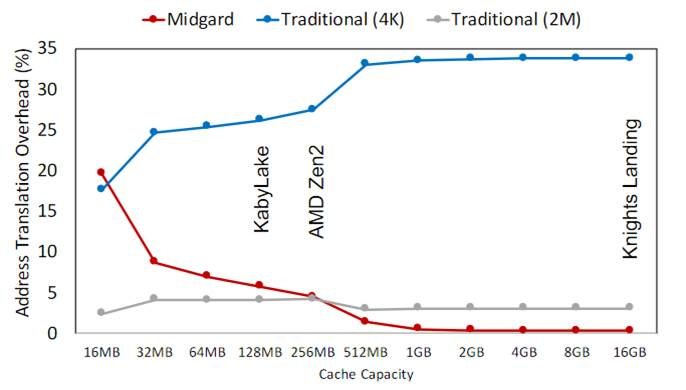Researchers at Ecocloud, the EPFL Center for Sustainable Cloud Computing, have pioneered an innovative approach to implementing virtual memory in data centers, which will greatly increase server efficiency.
Virtual Memory has always been a pillar for memory isolation, protection and security in digital platforms. The use of virtual memory is non-negotiable, even in widely-used hardware accelerators like GPU, NICs, FPGAs and secure CPU architectures. It is therefore vital that silicon should be used as frugally as possible.
As services host more data in server memory for faster access, the traditional virtual memory technologies that look up data in server memory and check for protection have emerged as a bottleneck. Modern graph analytics workloads (e.g., on social media) spend over 20% of their time in virtual memory translation and protection checks. Server virtualization for cloud computing, to help increase utilization of infrastructure and return on investment in data centers, dramatically exacerbates this problem by requiring lookups and protection checks across multiple layers of guest (customer) and host (cloud provider) software.
The way in which virtual memory is assigned in these servers is critical because, with such huge quantities of data involved, changes in strategy can have a massive effect on server efficiency and data security.
“Virtual memory technology has been around since the 1960’s, and lays the foundation for memory protection and security in modern digital platforms,” write the authors of “Rebooting Virtual Memory with Midgard”, a paper they will present next month at ISCA’21, the flagship conference in computer architecture.
Memory has become the most precious silicon product in data centers in recent years, as more services are brought online. Virtual memory traditionally divides up the physical storage into fixed size units, for optimal capacity management. This division slows down lookups and protection checks as memory capacity increases, because large regions of memory in application software (e.g., GBs) is disintegrated into millions of pages (e.g., KB). Modern chips (e.g., the recently announced Apple M1) employ thousands of table entries per processor to do lookups and perform protection checks for each memory access.
Namespaces are used to store unique references for data, in structured hierarchies. Removing some of this hierarchy and reducing the number of translations would represent a net gain in efficiency. The authors propose Midgard, which introduces a namespace for data lookup and memory protection checks in the memory system without making any modifications to the application software or the programming interface in modern platforms (e.g., Linux, Android, macOS/iOS).
With Midgard, data lookups and protection checks are done directly in the Midgard namespace in on-chip memory, and a translation to fixed size pages is only needed for access to physical memory. Unlike traditional virtual memory whose overhead grows with memory capacity, Midgard future-proofs virtual memory as the overhead of translation and protection check to physical memory decreases with growing on-chip memory capacity in future products filtering traffic to physical memory.
Analytic and empirical results described in the paper show a remarkable performance from Midgard when compared to traditional technology, or even rival new technologies (e.g., the larger fixed size pages used in certain applications). At low loads the Midgard system was 5% behind standard performance, but with loads of 256 MB aggregate large cache it can match and even outperform traditional systems in terms of virtual memory overheads.

Figure 1: The Average Memory Access Time for address translations on low-memory, high-memory and Midgard systems.
The authors conclude: “This paper is the first of several steps needed to demonstrate a fully working system with Midgard. We focused on a proof-of-concept software-modelled prototype of key architectural components. Future work will address the wide spectrum of topics needed to realize Midgard in real systems.”
Rebooting Virtual Memory with Midgard
S. Gupta; A. Bhattacharyya; Y. Oh; A. Bhattacharjee; B. Falsafi and M. Payer
ISCA 2021 48th International Symposium on Computer Architecture, Online conference, June 14-19, 2021.
Midgard etymology: a middle realm between heaven (Asgard) and hell (Helheim)